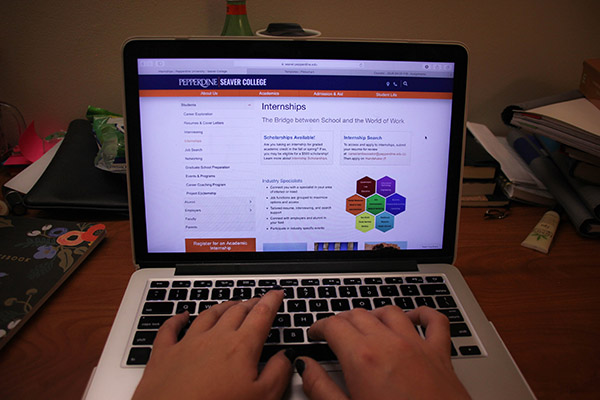
College students notoriously grumble about anything from a missing sock to an “unfairly” graded exam.
At Pepperdine University, students have little to complain about when it comes to their surroundings and panoramic views of the Pacific Ocean.
But peer into a cramped freshman dormitory at Pepperdine, and it is a different story. Dodgy, mismatched, stale facilities replace the once breathtaking view. Mold outbreaks, crumbling beds and outdated furnishings grace the 90263 address. A Pepp Post survey found that most students are satisfied with Pepperdine’s housing facilities, but all point to areas needing improvement.
“I wasn’t expecting it to be like ‘Zoey 101,’ but I thought it was going to be nicer,” said Graylen Goff, a sophomore sports medicine major.
Juniors and seniors, who have a choice on whether to live on or off-campus, must consider the advantages and disadvantages based on cost, past experience, social implications and their desired levels of independence.
On-campus options
Students must live on-campus for the first two years of their studies under the university’s policy.
“The heart behind the policy is that we want students to be involved in community for two years when they start to build those relationships before they live off-campus,” said Hannah Novak, administrative assistant for Housing and Residence Life and a Pepperdine alumna.
During those first two years, Novak said students may choose to live in “suite style” first-year houses, the Rockwell dorms or apartment-style living in Lovernich.
First-year housing does not have kitchen facilities, as all students are on cafeteria meal plans.
“I hate cooking,” said Meghan Doyle, junior communication major and resident advisor for the first-year house of Pauley. “I’m a terrible cook, so honestly not having a kitchen is not a huge loss for me.”
Sophomores living in Towers have a communal kitchen — for the entire building. If students think they can simply grab a pan and fry up an egg, they are rudely mistaken.
“The stove is weird,” Goff said. “We can’t use it unless you have this conductor plate.”
Setting aside wear and tear, a Pepp Post poll of 58 students found that 50 percent of students were satisfied with living on-campus and 10 percent were very satisfied. Another 20 percent were neutral and roughly 20 percent were dissatisfied or very dissatisfied with campus housing.
On-campus complaints
The Pepp Post found that air-conditioning, along with the general atmosphere and the bathrooms, were the top areas of discontentment.
After a mold infestation left her suitemates sick and temporarily room-less, freshman physics major Bailey Hammer said the repair imposed on her privacy and study efforts.
“There was just a lot of construction and times when you were doing homework or when you’re trying to take a nap,” Hammer said.
Hammer said her roommate’s bed also collapsed twice.
“Having to deal with that when you’re half asleep — not super fun,” Hammer said.
If students hate their bed frame for other reasons, too bad. Functionality supersedes cosmetic or personal preference.
Senior journalism major Marin Longfellow said she traded comfort for community when she transferred to Pepperdine. Bunk beds, and its hindrances, had to suffice until she moved into more “spacious” sophomore housing.
“I couldn’t sit up in my bed because my head would hit the ceiling,” Longfellow said.
Prioritizing repairs
A building’s infrastructure eventually deteriorates, even with drastic preventative measures. In students’ eyes, the first-year housing, Pepperdine’s oldest undergraduate living, is due for complete upheaval.
Both Novak and Luke Bost, associate director of Housing and Residence Life, said an overhaul is “cost prohibitive.”
Bost said the university prioritizes some repairs over others. Housing improvements are contingent upon funding and what “the university is thinking regarding master planning.”
Bost said this “plan” will eventually include either retrofitting the older dormitories or tearing them down. The university has additional regulations to follow because of its ocean location.
“At some point you have to replace them,” Bost said.
When probed further for prioritization, Novak referred these questions to the Department of Design and Construction, who ultimately sent these requests back to Housing and Residence Life.
Doyle said students in the dorm she oversees reported problems with the condition of their room, laundry malfunctions, dim lighting, power outages, fuse breaks and mold outbreaks.
“We’ve had to call facilities more this year,” Doyle said.
Novak said a lot of the complaints are unique to Malibu.
“There’s not a lot of water here most of the time,” Novak said. “In the fall months, we just get ants because they go inside looking for water. The fancy houses down on the beach gets those too, so it’s not just us. Sometimes the water smells like sulfur because we’re in Malibu, and it’s just the way things are.”
If students deem these circumstances unacceptable, they simply submit a request to Pepperdine’s Facility Services. Novak said Pepperdine employs “full-time, ‘round the clock” staff to fulfill these requests, ranging from “leaks” to dim-lit rooms.
On-campus perks
Most students said they are too involved in campus life to fret over living conditions. Longfellow said her emerging sorority commitments took precedence over her dorm’s features.
Novak, a graduate from Pepperdine, said she lived on campus throughout her college experience. She worked for Campus Ministries, which made her commute just a quick walk from Lovernich.
Novak said she did not regret her decision to stay on campus.
“Sometimes it would have been fun to live in a big ol’ house full of girls in Calabasas, but I think I have the rest of my life to do that,” Novak said. “I don’t have the rest of college to live on a college campus, surrounded by faculty and staff who also live here and are also part of the community.”
Doyle said former resident advisor Karl Kalinkewicz brought constant community to her first-year home in DeBell. Each Friday, Kalinkewicz would bring homemade treats to various dorms.
It’s memories like these that cannot be created in a four-story apartment complex.
“It’s not necessarily the building itself, but the people who live there that really made it home,” Doyle said.
Longfellow said out-of-state students may live on-campus to forego paying a vacant apartment’s rent during the summer.
“Where you live is really pivotal for the kind of person you’re going to become and who you live with is very formative,” Novak said.
Pepperdine is currently building Seaside, a new residence hall, which will house first-year students starting fall 2018. According to Pepperdine’s website, modernity and unobstructed ocean views will lure students, but not air-conditioning.
Bost said the new four-story construction will include green space, a community kitchen and gym.
Off-campus options
Come junior year, students have to decide whether to live on or off campus. As students reach the halfway point in their college career, housing becomes their most predominant subject matter. Most Pepperdine students live off-campus for cost, independence and overall well-being.
“Honestly, we literally are rejected from housing on-campus,” advertising major junior Katherine Sciortino said. “We applied for housing on-campus and didn’t get it.”
Out of the 3,314 undergraduate students enrolled at Pepperdine University, HRL officials said they “can house 2,100-2,200 students on campus.”
With those figures, over a third of students must live off campus — whether they want to or not.
Sciortino resides in Avalon apartments, which is a 12-minute drive away in Calabasas. She shares a two-bedroom apartment with three other girls, and pays approximately $630 per month, including utilities. Like Pepperdine, her apartment complex offers on-demand maintenance, and amenities such as a pool and gym.
Four students can share a two-bedroom, two-bathroom apartment with a one-year lease for approximately $530 per month, excluding utilities, at Malibu Canyon Apartments in Calabasas.
Many students forego on-campus housing for both a degree of separation and financial reasons. Pepperdine’s shared apartment-style living averages roughly $1,400 per month per student.
Longfellow lives in Malibu Beach Villas, located “right next to Nobu on the ocean.” She and five other girls each pay approximately $920 per month. Parking is the major downfall.
“There’s six of us, so we have to rotate spots every week, and if we’re not in the garage, then we have to park on PCH,” Longfellow said.
Longfellow said her car has been damaged while parking along the highway.
Off-campus complaints
Because off-campus students do not have the luxury of walking directly from their dorm to class, they must fight for parking spots.
Both Longfellow and Sciortino said this is not only stressful, but time consuming.
When students move off campus, they also take on additional responsibilities, financial decisions and have to invest in furniture and household necessities.
Off-campus perks
One of the biggest complaints from students with on-campus living is the feeling of big brother, and thus the biggest perk of off-campus living is independence.
Sciortino said she enjoyed the increased sense of freedom she gets off campus.
“Rules are different, and community is different,” Sciortino said. “You don’t have HRL or anything.”
As a then-junior, Longfellow said she was more than ready to settle into off-campus life.
“I am getting out of Pepperdine,” Longfellow said. “I want to be off campus. I want to have my own place to live.”
Although Doyle has enjoyed her time as a first-year residence advisor, she is looking forward to completing her Pepperdine chapter off campus.
“I think it’s just valuable to have a space where friends can gather and not think about school, and it’s really hard to do this on campus because campus is school,” Doyle said. “To be able to put in your hard day’s work on campus and retire with your friends off campus is healthy for your mental state.”
Sara Boesen completed this story under Dr. Christina Littlefield’s supervision in Jour 241 in spring 2017.



